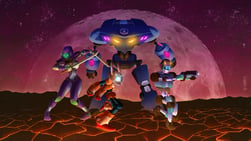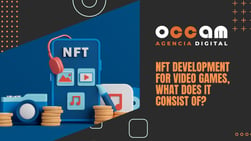What is the development of a video game and what are its stages?
Index Content
The launch of a video game is not the beginning of its journey. It is the starting point of a process that has been planned for months or even years. No matter what type of game it is or the platform on which it will be set: all video games go through a series of key stages to complete their development
In a growing and high-demand industry, video games have become a professional development space for digital artists, making it imperative that future video game designers and programmers are fully familiar with the stages of video game development.
Today we are going to tell you how a video game is developed and all the stages it has to go through to reach the final product.
will you join us?
how does video game development work?
Simply put, video game development is the process of creating a new video game for the market. More specifically, it is a complex production chain that takes a creative team of designers and developers through all the stages of video game development. It transforms the idea of a new game into a finished commercial product.
This process works with a well-organised workflow in which each member of the creative team knows what to do and when to do it. Scriptwriters, artists, designers, programmers, producers, engineers and managers must be aware of all phases of video game development to understand each other's role in the process.
Design encompasses the storyline and aesthetic vision of gameplay, characters and game elements. Development brings together all the creative processes to create a holistic product. There is no significant difference in the approach to game development, whether it is a console game, an online indie game or a mobile puzzler. They all start with the conceptualisation of the idea and end with the post-release tasks. But first things first.
what are these phases of video game development?
Phases of video game development
1# Planning
Before scriptwriters start writing, designers start designing and developers start developing, the idea for a video game has to emerge. This is the first part of the planning phase and the roots from which a video game starts.
In the planning phase, the most basic questions have to be answered, such as:
- what kind of video game are you going to produce?
- will it be 2D or 3D?
- what features should it have?
- who are the characters?
- when and where does it take place?
- who is the target audience?
- what platform are you going to build it on?
Although it may not seem like it, coming up with a video game is one of the most difficult parts of game development. The idea you start with is the backbone of the entire game. It is what sets the tone for everyone involved in building the game, but it also gives publishers a high-level overview of what to expect. This brings us to the next part of development: the proof of concept.
A proof of concept takes all the ideas that have been generated and sees to what extent they are viable for the game studio to produce. From there, further questions need to be answered, such as:
- what is the estimated cost to develop this game?
- do you have the technological capacity to build it?
- will you need a new game engine?
- how big will your team need to be?
- are you going to hire external voice actors and scriptwriters?
- what is your estimated timeframe for release?
- how will you monetise it?
Independent studios without publisher oversight have a little more flexibility at this stage. The downside of independent publishing is that you have to set a development and marketing budget.
Whichever path you take, a proof of concept is vital to the success of a game because it puts ideas into the perspective of what is possible. Now is the time to start pre-production.
2# Pre-production
The second phase of game development, known as the pre-production phase, is where you'll have to analyse your work, create storyboards and prototypes, and decide which ideas are winners and which are going to be discarded.
You will have to weigh every aspect of your game as a separate entity and as a cog in a big machine:
- Artists must make sure the art style and colour palette fit the theme and genre of the game - if your game is dark and sinister, like Tamashii, a 2D horror platformer, you don't want your artists working in bright, summery colours.
- Developers must define the mechanics and physics of the game, as well as how models and objects will be processed. Some of these decisions will involve artists, scriptwriters and engineers, depending on how they affect the script or gameplay.
- The engineers will have to tell the team what their limitations are. The scripting team may want a big cinematic ending that the game engine cannot render. The developers may want a mechanic that could cause performance problems. Now is the time to set the limits
- Project managers are the intermediaries who balance the demands of each team, make the final decisions, remove obstacles and keep everyone on the same page.
- Scriptwriters must define the script, the characters and the world they live in, and the script will influence the art, mechanics and environments that need to be created.
If you're an independent developer in charge of a project, you're responsible for all of these areas. It's a lot to juggle alone, but with fewer cooks in the kitchen, you have the freedom to create your game your way.
Your ideas start to find shape and voice in pre-production, but with so many moving parts, you'll need to be flexible. It's rare for a game to get through the planning and pre-production phase without some sacrifices.
Whatever problems you run into in the other phases of development, the decisions you make in pre-production will be the ones that keep the project on its foundations.
3# Production
Most of the time, effort and resources invested in game development go into the production phase. It also happens to be one of the most difficult stages of game development. During this process, character models are designed:
- Character models are designed, rendered and iterated to look exactly as they should in the story.
- The sound team works tirelessly to ensure that every time the character steps on sand, gravel or concrete, it sounds authentic.
- Level designers create dynamic, immersive environments suitable for many types of play styles.
- Voice actors read large stacks of scripts, doing take after take to get the right emotion, pacing and tone.
- Developers write thousands of lines of source code to bring each piece of game content to life.
- Project managers set milestones and sprint schedules, making sure that each department and its team members are held accountable. This is especially important if an editor regularly checks the status of the project.
These and many other aspects can take years of work, and that's assuming only a few changes are made along the way, which is rare.
In video game development, it is not uncommon for entire segments of a game (months of work) to be scrapped after completion. You can imagine how frustrating this is for the employees involved. These kinds of changes are often brought up in the testing phase.
4# Testing
The testing phase looks like a lot of fun from the outside, but it is a huge and exhaustive job.
In this phase, you have to test every single aspect of your game to hunt down any bugs, glitches, exploits or softlocks that may have crept in.
Here are some of the things a tester might point out during this phase:
- are there areas or levels with bugs?
- does everything look right on the screen?
- can I get through this wall or a locked environment?
- is there a feature I can use to exploit the game?
- is my character permanently stuck at this point?
- are the characters' dialogues boring?
It is not only about stability, but also about the "fun factor", i.e. what makes the game fun.
Making sure that the story is engaging, the mechanics are entertaining and the puzzles are rewarding is just as important as the technical stability of the game. Otherwise, the game will not sell.
5# Pre-release
Pre-release is the time when the marketing strategy kicks in. By now, you should have a stable beta version of your game ready to present to the public.
Studios use teasers, promotional images, cinematic trailers, gameplays, game streamings with influencers and other strategies to promote a game and make it known to the public.
This is one of the most exciting and nerve-wracking phases of the game development process: you're finally ready to show all your work, but you have no way of knowing how it will be received.
Independent studios don't always have the luxury of big marketing budgets to bring attention to their games. Fortunately, crowdfunding and advertising can be just as fruitful. Sending early access beta copies to influencers or famous industry gamers so they can live stream their experience playing is a great way to reach the audience you're looking for.
6# Launch
The months leading up to a game's planned release date are mostly spent removing a large number of bugs, some old and some new bugs found in the testing phase. For games with a lot of bugs, the studio will create a hierarchy of bugs to remove. This hierarchy will include "game-crashing" bugs at the top and minor bugs at the bottom.
In addition to removing bugs, developers often polish the game as much as possible before release. Maybe that mountain range can have more depth. Maybe the leather straps on the characters can have more texture. Maybe the trees can finally sway in the wind. These kinds of changes, while minor, can be important in making a video game more immersive.
7# Post-release
The game is already in the hands of the players, but the work is far from over.
Usually in this early post-launch phase, players start to notice bugs or other bugs within the game, forcing developers to fix these issues.
Another part of the post-launch phase is to periodically update the game software. These updates range from patches to balance the game to new downloadable content or DLC.





